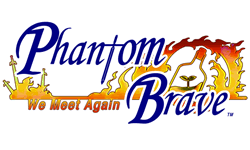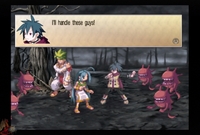|
|

|
PLATFORM
|
Wii
|
BATTLE SYSTEM
|

|
INTERACTION
|

|
ORIGINALITY
|

|
STORY
|

|
MUSIC & SOUND
|

|
VISUALS
|

|
CHALLENGE
|
Moderate
|
COMPLETION TIME
|
40-60 Hours
|
|
OVERALL

|
+ Highly customizable characters.
+ Quirky music.
- The story wavers between cute and too-cute.
- Grinding!
|
Click here for scoring definitions
|
|
|
Two types of people are interested in Phantom Brave: We Meet Again. There's a joke in here somewhere, but also a suggestion on how to read this review. Those who first played Phantom Brave on the PS2 should feel free to jump to the final four paragraphs, where the Wii-exclusive content is explored in depth. First-timers interested in NIS America's gridless tactical RPG should continue reading as usual; all will be revealed in time.
Phantom Brave: We Meet Again is the story of Marona, a young cursed girl. Nobody likes her because she is able to summon the spirits of the dead and bind them to the physical world. Despite this grim talent and her life of isolation, Marona's a cheerful sort -- a real green-haired Pollyanna. She meets all of her difficulties with cheerful smiles and the belief that she will persevere -- after all, she has the aid of Ash, the phantom who died alongside her parents so many years ago. Whether Marona's unable to find mercenary work because of her rotten reputation or trying to save the habitats of endangered monsters, her can-do attitude and belief in the power of the human spirit carry the day.
Phantom Brave's fundamental optimism is one of its story's greatest strengths as well as its most potentially grating aspects. Although Marona's world is cruel and its inhabitants are overwhelmingly petty, she's able to force her way through by depending on friendship and love. Both of the game's language tracks lend to the exceptional cuteness, blending chirpy "moe" anime voices with inflections and character types from the earlier days of American animation. The overall effect is that of playing a child's fairy tale, punctuated by moments from a more traditional Brothers Grimm story. Although rare, there are moments of violence or angst made more shocking by their innocuous surroundings. That isn't necessarily a concern, however, merely an observation. What is worth mentioning is the divide between the light-heartedness of the story and the tactical cunning that is necessary to make it through the game without endless, frustrated grinding.
Even with rock-solid tactics, grinding for experience is practically a necessary feature of Phantom Brave. There are techniques to make it more bearable, but the repetition never wholly goes away. High-experience maps and the generic dungeon levels will become familiar sights. The Wii-exclusive "Another Marona" story tries to balance the issue by providing grinding-specific maps with weaker enemies and experience boosts, but they feel like stopgap measures attached to a flawed system rather than addressing the core problem.
The grinding process is made marginally more interesting thanks to the weapon upgrade system. Every weapon starts out with an unimpressive number of special attacks. Using the weapon earns mana, which can in turn be poured into more impressive attacks. For example, the standard mine-cart begins with the ability to be used as a bludgeon with which to hit monsters. Through upgrades it gains the ability to be set on fire, driven irresponsibly, or transformed into a ghost train with a two-way ticket to the Netherworld. These attacks are tactically varied, differentiating from each other by area of effect, damage caused, cost, and key statistic. Furthermore, many of them are hilarious. Most abilities can be transferred from weapon to weapon through the item fusion system, allowing the unique techniques from several different items concentrated in one super-weapon. This can lead to creations such as all-purpose combat bread, explosive fish, and packing crates stocked with full compliments of axe techniques. Characters can be combined in a similar fashion -- they're only phantoms, after all. Why not squash them together? Creating the ideal party requires learning the secrets of several interrelated crafting systems, which will appeal to both hardcore number jugglers and fans of the absurd.
 No you won't, Ash!
No you won't, Ash!
|
|
Not all of this stat-crunching is necessary to complete the game's normal missions, although it can ease the grind; vigorous manipulation of the statistic systems only becomes integral during the post-game missions. Otherwise, combat is a mixture of the dynamic and the aggravating. Even the most routine battle is tense due to Phantom Brave's confine system. Marona is the only character in the party who is present for the entirety of each battle. All other allies are summoned temporarily, their spirits bound to battlefield objects such as tree stumps and weathered pillars. Building strategies to manage the constant flow of allies can be an enjoyable exercise: each type of battlefield detritus provides different stat modifiers, so character placement takes special importance. Is it worth confining the burly knight to the anthill? It would increase his attack power, but he may need a speed boost instead. What if the anthill is in a distant corner of the screen, would serve better as an impromptu weapon, or does it have a conditional modifier like continual damage on it? Moreover, when should the knight be confined? If he's summoned too early, there may not be enough allies for mop-up duty -- too late, and that time will never arrive.
When the planning fails however, battle isn't so fun. It's easy to view the confine system as an artificial difficulty imposed on the game, despite its relevance to the story and in balancing the different character classes. There's nothing as annoying as completing a difficult level except for one inconsequential enemy, only to find that all of the allies who could have harmed it have already been summoned and left -- especially if this enemy is on the final floor of an extended dungeon run. Other nits worth picking within the battle system include the difficulty in targeting some attacks, and the mediocre AI. Enemies will occasionally "forget" to attack or be unable to do anything useful because they're bumping around the battlefield. While these moments can cause welcome respites from damage, they also add a shade of luck to the battles. Victory is sometimes contingent on how many monsters run off the edge of the screen rather than any player-influenced action.
Phantom Brave generally benefits from being on the Wii, even though it never displays any signs taxing the system. The menus are easy to navigate, and the Wii Remote/Nunchuck setup makes interacting with all of the moving parts in each battle pretty simple. Comparing character statistics and items requires some unwieldy finagling, unfortunately. For the most part, the graphics are high-quality sprites. While cute and effective at communicating the characters' different expressions, they're not pushing any envelopes. On lower-end TVs, they aren't nearly as crisp as in the provided screenshots. This applies to the text too, making reading portions of the game difficult.
 Upgrading weapons is fun!
Upgrading weapons is fun!
|
|
One area of the Phantom Brave that is less ambivalent than the rest is the music. Tenpei Sato is some kind of fun-loving aural hero, sharing both bounce and depth through his songs. Although the soundtrack contains hints of the Disgaea series' goofy elasticity, it runs the gamut of styles from the smooth jazz of "B-A-R" to the tender-hearted strings of "Friend." Along the way, Sato dips into jungle drums and enough non-standard fantasy instruments to capture the feel of a fairy tale archipelago. As always with tactical RPGs, the multiple battle tracks aid the tedium of the grinding process.
The newest, and most hyped aspect of Phantom Brave's outing on the Wii is the additional story, entitled "Another Marona." This story is similar to Etna Mode in Disgaea: Afternoon of Darkness in that it plays looser and more comedically with the characters and their world. Unlike Etna Mode, "Another Marona" has a distinctly grim edge -- certainly more so than the main game. Playing through it reveals further details about Marona's character as well as her relationship with Ash. The side characters aren't as convincingly developed, but fans of somber Walnut and obsessed Sprout will have the chance to add the characters (among other, lesser luminaries) to their rosters. "Another Marona" is accessible immediately, but will also accept a completed save file from the main game. Similarly, a completed save file from "Another Marona" is transferable into the main story. Both options will make the story missions unbalanced, but making a complete circuit of the two will provide useful tools for the post-game challenge maps. Overall, the additional scenario is enjoyable, but not enough to warrant repurchasing the game for the sole purpose of playing new content.
Despite its numerous small annoyances, Phantom Brave: We Meet Again is a fun game -- albeit hardly essential. It's no Disgaea, but an enjoyable diversion in a familiar mould. The confine system sets it apart from NIS America's other games, but not far enough that the game should be a surprise to anyone who has experienced other games in the genre. RPGamers who enjoy fiddly tactical RPGs may want to check it out, especially those who are also lovers of sweetness and idealism.
Review Archives
|









